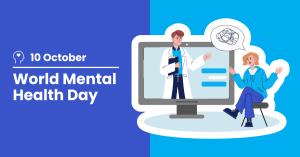Video Telemedicine – A Bridge to Mental Health
Given the notable surge in anxiety and depression across all EU nations during the pandemic 1 with a particular impact on young individuals, the provision of care and access to therapeutic services is essential. According to The Health at a Glance Report, Ireland had one of the highest rates of mental health disorders in Europe (2016), with around 18.5% of its population facing issues such as anxiety, bipolar disorder, depression, or substance abuse 2.
However, geographical barriers, lack of accessibility, and sometimes even a lack of confidence and comfort in unfamiliar surroundings often limit the reach of needed psychological help. In this context, video telemedicine emerges as a vital bridge to mental wellbeing as it transforms the way people access mental healthcare. The pandemic triggered profound changes across various sectors, including psychology. While many areas returned to normalcy as health restrictions eased, the adoption of virtual therapy, often termed ‘teletherapy,’ became an experimental practice embraced by mental health experts and patients alike, seamlessly becoming part of their global routines 3.
Video Overcomes Geographical Barriers and Improves Accessibility
Traditional therapy is often limited by location, making access to mental health care difficult. People living in rural or remote areas face significant challenges in seeking help. Travelling long distances to receive therapy is costly and emotionally draining, which can discourage people from seeking help.
Indeed, location is not the only limitation to healthcare access. There are additional barriers, such as physical disabilities, demanding work schedules, or mobility limitations. In some cases of severe depression, patients feel more comfortable and are more willing to open up to the professional if they remain in a routine/home environment. Video therapy, as supported by Bashshur et al. (2016) 4, makes mental health services more accessible, by providing an inclusive and convenient solution to these challenges. By adapting to people’s individual circumstances, psychological care ceases to be a privilege and makes mental health more accessible than ever before 3.
Mental Health Video Consultation Experiences
Many mental healthcare professionals have embraced video telemedicine using tools such as BlueEye Clinic. Video technologies can help a greater number of patients who face barriers on a daily basis with a simple click.
Video telemedicine not only benefits mental health experts by expanding their reach but also has a direct impact on patients’ mental health. Sample case studies show how these technologies transform the way psychological care is delivered.
Teenage girl, age 19, Dublin, struggled with social anxiety and avoided in-person consultations. She has experienced significant improvements in her mental health over the past 12 months thanks to the convenience and privacy of video therapy from her home.
Man, age 32, Ireland, lived far from the city and was unable to access treatment for his depression due to a lack of local therapists. Telemedicine allowed him to easily connect to the city mental health services, without the need to travel long distances, transforming his life.
Video telemedicine has emerged as a crucial tool for breaking down the barriers that often hinder access to mental health care. As an increasing number of mental health professionals adopt this technology, it becomes progressively feasible for individuals to access the assistance they need, irrespective of their personal constraints. “Teletherapy” offers numerous benefits, including enhanced patient privacy, a reduction in the stigma associated with in-person visits to clinics or offices, heightened convenience through reduced travel and fewer disruptions to daily activities like work and childcare. Additionally, it improves accessibility for patients who may encounter challenges leaving their homes, such as individuals with disabilities, older adults, and parents of children with autism spectrum disorder 5.
If you are seeking psychological care or are a mental health professional interested in expanding your services, feel free to contact us to learn more about BlueEye Clinic’s services and contribute to more accessible and effective mental health. We are here to help you build a path to mental wellness without obstacles.
References:
- OECD (2023). 2022 Health at a Glance: Europe. Available https://health.ec.europa.eu/state-health-eu/health-glance-europe_en
- Research – Mental Health Ireland. (n.d.). https://www.mentalhealthireland.ie/research/#:~:text=The%20Health%20at%20a%20Glance,alcohol%2Fdrug%20use%20in%202016.
- Flores, R. (2023). Teleterapia: Un fenómeno que llegó para quedarse. La Tercera. https://www.latercera.com/piensa-digital/noticia/teleterapia-un-fenomeno-que-llego-para-quedarse/23ZAG64XBBCPRFR7RLXTSDDXYM/
- Bashshur RL, Shannon GW, Bashshur N, Yellowlees PM.The Empirical Evidence for Telemedicine Interventions in Mental Disorders. Telemed J E Health. 2016;22:87-113. 10.1089/tmj.2015.0206
- HRSA (2022) Individual teletherapy. Telehealth.hhs.gov. https://telehealth.hhs.gov/providers/best-practice-guides/telehealth-for-behavioral-health/individual-teletherapy
- Arafat MY, Zaman S, Hawlader MDH. (2021) Telemedicine improves mental health in COVID-19 pandemic. J Glob Health. 7;11:03004. doi: 10.7189/jogh.11.03004. PMID: 34326984; PMCID: PMC8294826.
- Griffiths L, Blignault I, Yellowlees P. Telemedicine as a means of delivering cognitive-behavioural therapy to rural and remote mental health clients. Journal of Telemedicine and Telecare. 2006;12(3):136-140. doi:10.1258/135763306776738567
- Arafat MY, Zaman S, Hawlader MDH. Telemedicine improves mental health in COVID-19 pandemic. J Glob Health. 2021 Mar 7;11:03004. doi: 10.7189/jogh.11.03004. PMID: 34326984; PMCID: PMC8294826. link: https://www.ncbi.nlm.nih.gov/pmc/articles/PMC8294826/pdf/jogh-11-03004.pdf
- Source: Zhou X, Snoswell CL, Harding LE, Bambling M, Edirippulige S, Bai X, et al.The Role of Telehealth in Reducing the Mental Health Burden from COVID-19. Telemed J E Health. 2020;26:377-9. 10.1089/tmj.2020.0068
- “Treating Depression with Telemedicine. Chiron Health. 2016. Available: https://chironhealth.com/blog/treating-depression-telemedicine-offers-results-person-visits/
- Mariano, A. R. (2004). Teleterapia virtual: un nuevo paradigma de telemedicina para el tratamiento de trastornos psicológicos. Dialnet. https://dialnet.unirioja.es/servlet/tesis?codigo=216606


